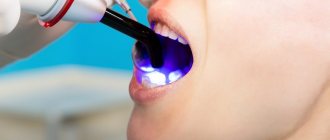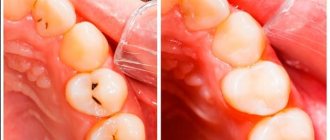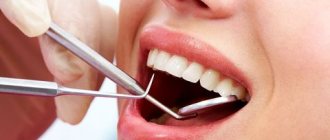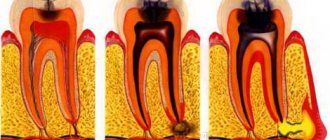A photopolymer filling is a modern filling material based on a composite substance that changes its state of aggregation under the influence of light rays of a certain length. Light composite has a whole range of advantages over traditional analogues, including: increased strength, durability, resistance to pigmentation, comfort of work for the dentist, etc.
After hardening of the photopolymer composite, the filling is reliably connected to natural dental tissues and acquires maximum strength. It is installed in the treatment of a wide range of dental pathologies and is the most popular solution in modern dentistry.
What is a photopolymer filling?
Photopolymer filling is a popular and convenient way to restore teeth, which uses photopolymer materials.
Composites harden in the oral cavity solely under the influence of a specific wave of light emanating from a lamp. Thanks to this property, the dentist can do his work slowly and creatively.
In addition, light-reflecting composites are available in different colors and degrees of transparency, and accordingly, with their help it is possible to hide darkened hard tissues and even metal, as well as restore enamel and dentin.
There is also technology that allows you to combine reflective and chemical materials. It is in this case that it is possible to make the most of all the advantages and neutralize the disadvantages of each method.
There are many reasons why photopolymer fillings are widely used in dentistry. The risk of cracks occurring during operation is minimized. All functions of the teeth are completely restored, while the patient’s sensations remain the same as with healthy teeth.
How much does treatment cost?
The amount depends on the material. For example:
- Conventional composites without installing gaskets cost about 3 thousand rubles.
- Glass ionomer cement will cost more, 4000.
- Ceramic inlay excluding work performed - 3500.
- Metal can be supplied cheaply, for 1,500 rubles.
It is more accessible to treat children. This is due to the speed of the process, which takes place much faster. On average, parents pay about 2 thousand. Old elements are removed for 700 rubles; setting up a diagnostic design, as a rule, does not exceed 1000.
It is not recommended to save on filling products, especially when it comes to deep lesions of dentin tissue. The patient will be able to forget about dental problems for a long time and will not experience any inconvenience.
What does the cost depend on?
The final price consists of many factors that are taken into account by the clinic’s specialists when making calculations. As a rule, the following points are important:
- materials used;
- use of expensive equipment;
- size of the affected area;
- number of dental visits;
- professional experience, qualification category of a doctor;
- location of the clinic.
Don't be surprised to see a tidy sum on the check. Achieving quality results can be difficult. Sometimes more than one visit to the dentist’s office is required, including the installation of a temporary structure and the placement of medication to kill the nerve.
Thus, the cost directly depends on the stages of treatment. Standard list of services:
- initial examination;
- cleaning affected areas;
- application of a medicinal product;
- anesthesia, local anesthetic;
- panoramic or spot shot;
- cleansing and formation of channels;
- filling;
- installation of a diagnostic or permanent product.
The price list can be found directly at the medical institution or on the website (usually such information is provided in detail).
Kinds
Regardless of the type, a composite material is used to make a photopolymer filling. He can be:
- macro-filled;
- microfilled;
- minifilled;
- hybrid;
- compomer.
In addition, composites are divided into fluid and solid. They are placed in syringes and applied to the surface to be treated using tools specially designed for this purpose. Conventional ones are not suitable for this purpose, as the material will stick to them.
In case of restoration of the interdental contact point, as well as when filling the cervical area, they resort to the use of fluid polymer fillings.
It is they that fit as tightly as possible and are evenly distributed over the surface, due to which they create tight contact with hard tissues. They are easy to use. In this case, the possibility of applying more composite than necessary is completely excluded.
Let's find out why a tooth hurts after a temporary filling
In the process of restoration of anterior teeth, it is customary to use solid photopolymers. They are plastic, thanks to which they can give the tooth any shape and will fully correspond to the anatomical structure.
When restoring a large cavity, the material is applied in layers, since the rays of the lamp cannot penetrate into the deep layers. For more reliable fixation, the enamel is highlighted first and only then the remaining areas.
Indications and contraindications
There are a number of indications for which the use of photopolymer materials is used. The main ones:
- tooth fracture;
- change in color of enamel that cannot be bleached:
- significant defects of tooth enamel;
- the presence of large fillings in the cervical area;
- noticeable interdental gaps;
- the need for minor correction of the position of the teeth;
- damage to the crown by a maximum of forty percent.
Even if there are indications for installing a filling, a specialist may refuse to carry out the necessary treatment. Among the main contraindications for installation are the following:
- bruxism;
- severe destruction of the front teeth;
- active development of caries;
- teeth subjected to intensive fluoride treatment;
- lack of proper oral hygiene.
Some of the contraindications are classified as conditional. Over time, they can be eliminated, and, accordingly, there will no longer be barriers to installing fillings made of photopolymer materials.
Is anesthesia necessary in all cases?
Regardless of whether a Japanese dental filling is used or a product from another manufacturer is installed, anesthesia is a prerequisite. This not only helps to quickly eliminate pain, but also ensures the impeccable quality of the work performed, since the dentist has free access to the damaged cavity.
However, the use of strong painkillers is not recommended in all cases. If a superficial lesion is detected, to reduce sensitivity it is advisable to apply the application to a shallow depth (no more than 3 mm). Usually the cost of such a procedure does not exceed 200 rubles. In case of massive destruction, the cost of pain relief can reach 1 thousand rubles.
Installation
The process of installing a photopolymer filling is carried out in several stages. Most often, treatment is carried out according to this plan:
- Administration anesthetic drug.
- Preparation of the area affected by caries.
- Treatment with medications.
- Isolation of saliva and mandatory drying.
- Application of acid to improve adhesion.
- Thorough rinsing and drying.
- Application of adhesive material.
- Layer-by-layer application of the composite.
- Polishing and grinding.
If the depth of the lesion is too great, then additionally resort to the use of a therapeutic and insulating pad. If dentin layers are damaged, they must be isolated. In those cases when the cavity is excessively large, first a medicinal material is placed into it and only then an insulating material.
The process of etching the enamel can be carried out both before and after insulation. The gel, which contains orthophosphoric acid, is applied exclusively to the dried surface. Only in this case will it be possible to achieve the desired effect.
After applying the adhesive system, it is sprayed using an air stream. Then the material is illuminated with a lamp for literally half a minute. The filling is formed by layer-by-layer application of reflective material.
At the final stage of installation, the filling is ground, removing all irregularities and polished. The tooth acquires natural smoothness and shine. It is almost impossible to distinguish it from natural one.
Care
The rules for caring for photopolymer fillings are practically no different from ordinary oral hygiene.
Patients simply need to brush their teeth regularly with a soft toothbrush and rinse their mouth with warm water or a special solution after each meal.
It is also important to regularly, at least once every six months, have a routine examination with a dentist. Only if problems are detected in a timely manner can they be easily eliminated and the development of more serious diseases prevented, and accordingly preserve the integrity of the tooth that has been restored.
Alternatives
There can be two alternatives for restorations:
- Removal and installation of a dental crown made of ceramics or metal-ceramics.
- Inlays instead of fillings. They are more expensive, but have a long service life and are also very reliable.
Photo of a dental inlay and crown
In conclusion, we can conclude that all types of fillings for restoration after caries are different and, accordingly, have different service lives. It’s better, of course, to spare no expense and get a good filling done once, than to go to the dentist every six months and get a new restoration done. Regarding the need for such a procedure, the patient must understand that the teeth must be not only healthy, but also beautiful, and therefore they cannot do without restoration after treatment.
The fillings do not require special care; you just need to follow the usual rules of hygiene and then caries will leave you forever. If we take into account all the pros and cons, then restoration with any types of fillings is the best solution after caries treatment.
Life time
The service life of photopolymer fillings largely depends on the quality of the material and the competence of the specialist. In addition, the patient himself is able to both shorten and significantly extend the service life of the filling.
The materials used in the filling process can be either highly durable or less reliable. Provided that a high-quality composite is used, it can last up to seven years.
There are cases when the filling falls out almost immediately after its installation. There may be several reasons for this. It is possible that when filling, the doctor made a mistake, as a result of which the material was not securely fixed. The most common cause is adhesion failure due to saliva or liquid.
Find out why a tooth hurts after filling
In such cases a guarantee is issued. Within a year after the filling is installed, the patient can apply for a repeat procedure. There is no charge for the service.
It is also possible that the patient simply did not follow all medical recommendations. In this case, you also need to seek help from a specialist. It is advisable to give preference to those clinics that have only positive recommendations. In this case, the risk of the filling falling out will be minimal.
Let's sum it up
There are many types of dental fillings for filling teeth, which differ in materials of manufacture, purpose and other criteria. The type of product is selected together with the attending physician. In this case, it is important to take into account the quality of adhesion to natural surfaces, aesthetic properties, hardening speed and other points. For many patients, the cost of installation is a deciding factor, so strength and durability take a back seat.
The price depends on many factors, for this reason it is important to carefully consider the choice of treatment method. Having figured out what types of permanent dental fillings there are (the names of the types are discussed above), you can forget about pain and other discomfort for a long time, enjoying a dazzling smile.
Do's and don'ts after installation
When installing light fillings, the doctor gives a number of recommendations, following which it is possible to preserve their integrity for many years. The most important of them are the following:
- Eliminate viscous foods from the diet that can lead to loss of the composite.
- Avoid excessively hard foods such as nuts and crackers, especially in cases where the front teeth have been restored.
- Get rid of the habit of biting your nails and biting threads.
- Brush regularly, at least twice a day .
- professionally once every six months . In this case, be sure to inform the specialist that photopolymer fillings have been installed and indicate their exact location.
- For several days after the filling is installed, do not eat foods that contain dyes. Otherwise, the material will darken and the tooth will lose its natural appearance.
The main advantage of fillings made from photopolymer materials is that you can eat food immediately after the procedure. If chemicals are used, it is necessary to wait at least two hours for the cement to completely harden.
Advantages and disadvantages
The demand for photopolymer fillings is due to a number of their advantages. The main ones are the following:
- it is possible to accurately restore the relief and shape of teeth even in cases where they are too damaged;
- the filling is combined with hard tissue into a single whole thanks to a special adhesive system;
- after hardening, the material becomes durable, securely bonded to the enamel, and resistant to cracking;
- it is possible to achieve the desired cosmetic effect by selecting the desired color shade of the material;
- installation is carried out by applying the composite layer by layer, thereby creating an imitation of natural dental tissues;
- preparation of cavities and defects is reduced to a minimum;
- In case of delamination or chipping, adhesive correction is possible.
Among the disadvantages of such fillings, one can highlight only shrinkage of the composite when exposed to light and insufficient polymerization. The polymer does not harden completely, and therefore the original shade may change over time.
Photopolymer fillings have many advantages, which is why they are most often used in dentistry. This is a reliable type of dental restoration, with the help of which it is possible to give even severely damaged hard tissues a natural appearance.
Another peculiarity of the use of light composites is that the material hardens only under the influence of a special lamp. Accordingly, the specialist has the opportunity to clearly recreate the natural shape of the tooth, which is very difficult when using other materials.
Cement materials
Cement differs significantly from composite in its lower hardness, however, it is able to protect the tooth from repeated carious development. A disadvantage is the high density of cement compared to tooth tissue: over time, this contributes to the thinning of the crown surface adjacent to the filling.
Cement compositions have three subtypes, according to additives to the main ingredient:
- silicate;
- phosphate;
- glass ionomer.
Silicate compounds are the oldest of all. The material contains special glass mixed with phosphoric acids. The silicate composition has a different release of fluoride, which prevents the development of dental caries. The harmfulness of the material lies in its aggressive phosphoric acid, which destroys the pulp. To neutralize the effect of acid on the pulp tissue, a special gasket made of safe substances was installed.
Phosphate compounds are characterized by fragility and fragility, weak adhesion (adhesion to tooth tissue), and high abrasion. The peculiarity of these fillings is their high toxicity, which provokes the proliferation of aggressive bacteria. This substance (phosphate) does not protect well against the re-development of caries.
Glass ionomer cement is used to treat children. The substance is as close in texture as possible to dental tissue, has high adhesive characteristics and safety. The glass ionomer is illuminated with a special ultraviolet lamp, which promotes rapid hardening of the material and high-quality tooth protection from infection. The advantages of this material include the fluoride contained in the composition, which protects against the development of recurrent caries.
The disadvantages include fragility - softness and instability of the composition. In modern dentistry, strengthened glass ionomer is used, the composition of which is supplemented with metal or ceramic particles. This material is used for filling chewing molars; it is most resistant to abrasion. The last word in the development of dental materials is the production of nanoionomer, which reliably protects dental tissue from infection and the development of caries.











